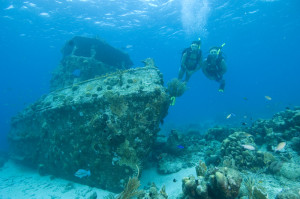In a previous post, I talked briefly about the PADI Adventures in Diving program and the related certifications, PADI Adventure Diver and PADI Advanced Open Water Diver. Time to look at the program in depth.
Not so long ago, to become an Advanced Open Water diver, you only had to compete four dives beyond the ones you did for your Open Water Diver certification. Those four dives were required to be: a deep dive (beyond sixty feet), a navigation dive, a search & recovery dive and a night dive. This has evolved over the years.
Often, newly certified divers are daunted by the name “Advanced Open Water Diver. Many have thought that you need to be an advanced diver to take the course. PADI realized what was wrong and restructured the program under the title Adventures in Diving. While there is still an Advanced Open Water certification, it is part of this program. Rather than needing to be an advanced diver, the program advances your knowledge and skills and makes you an Advanced Open Water Diver.

These divers are diving in a remote location and should probably have an extended amount of emergency oxygen.
Adventure Diver? Advanced Open Water Diver? What’s the difference? Two essential differences are the number of dives and the required dives. Both certifications require you complete Adventure Dives, dives that are specific to a specialty area of diving. Here’s a short list of potential Adventure Dives:
- Altitude
- Boat
- Deep
- Fish Identification
- Enriched Air
- Digital Underwater Photography
- Search & Recovery
- Night Diving
- Navigation
- Underwater Naturalist
- Peak Performance Buoyancy
- Sidemount
- and many, many others
For the Adventure Diver certification, you need to only complete any three Adventure Dives. For Advanced Open Water, you need to complete the Deep Adventure Dive and the Navigation Adventure dive plus any three other Adventure Dives.
Here’s the awesome part: you can probably complete the dives in a weekend. Yes, two days of diving can take you from Open Water Diver to Advanced Open Water Diver. Or one day to go from Open Water to Adventure Diver.
So, why do it? There are many reasons. At some dive sites and for some dive operations, they’ll only take you on some dives if you can show proof of training beyond entry-level (Open Water Diver). For many operators, the Advanced Open Water Certification is required before they’ll take you on dives deeper than sixty feet. Okay, that’s the regulatory requirement. On the fun side, think of the Adventures in Diving program as the sampler platter for specialty areas. You get to try out different activities before jumping in. Maybe you’re curious about night diving, but aren’t ready to do the three-dive Specialty. You just want to try one night dive to find out.
If you find out that there is something you really like to do, like using a Diver Propulsion Vehicle (DPV or scooter), you can continue your training and earn the respective specialty certification. Here’s how that works: The Adventure dive in a specific specialty area (e.g., Altitude, Boat, Deep, etc.) is the same as the first dive in the respective Specialty. That means that, at your instructor’s discretion, the Adventure Dives you complete for Adventure Diver or Advanced Open Water can count towards the Specialty. But the flip-side holds true as well. If you complete any three Specialty diver courses, you can earn the Adventure Diver rating (you’ve complete those three dives, right?) And, if you’ve completed the Navigation Specialty and Deep Specialty and three other diver specialties, you can earn the Advanced Open Water Certification.
There can be many individual reasons to complete the Adventure Diver or Advanced Open Water rating, too. Perhaps as a personal diver-improvement. Or maybe you’re tracking towards Master Scuba Diver. Or maybe you just want to see what divers do for fun. Regardless, if you’re an Open Water Diver, think about your next step being in the Adventures in Diving program.
